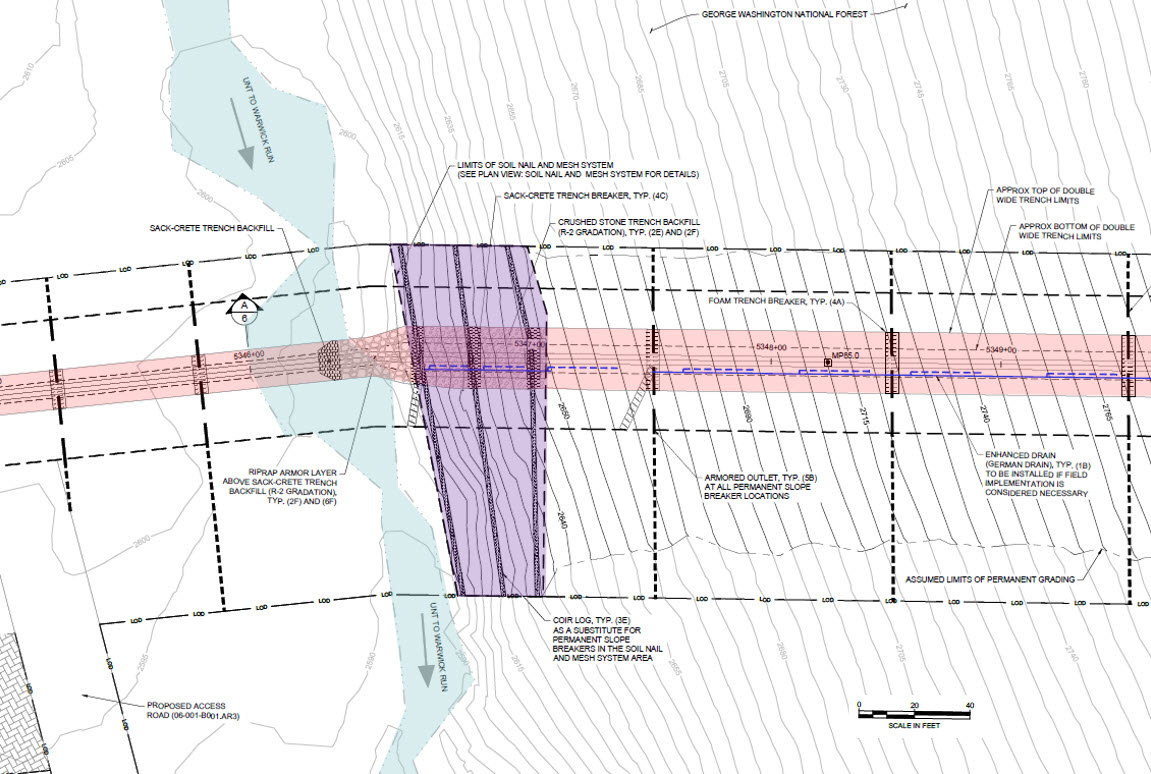Dominion Energy asserts that the ACP has received an unprecedented level of regulatory review, and it’s time to get on with it. Meanwhile it withholds its real construction plans while expecting broad waivers from environmental conditions and standards.
Dominion has persistently failed to make site-specific construction plans available to the regulatory agencies and the public. It has instead provided low-resolution plan sheets and generalized descriptions of environmental control practices. We now know that Dominion has plans that it has not shared with government decision makers, and we know it seeks exemption from critical regulatory requirements.
Undisclosed Construction Plans
Regular Best Management Practices for erosion, sediment, and stormwater control have limited effectiveness for steep-slope construction. Dominion has addressed this by promising to implement what it calls a Best in Class program wherever slopes are 30% or steeper for 100 feet or more –over one-third of the pipeline corridor in Virginia’s mountain counties. Our DEQ, however, has not gained access to actual site-specific plans for these high-hazard areas. Dominion has instead presented a menu of options that it might apply, ranging from specific structural methods to detail-free generalities such as “site-specific engineering.”
Although the DEQ has not been privy to all of Dominion’s plans, the curtain was pulled back in February 2018 when Dominion submitted site-specific plans to the Forest Service for six high-hazard locations. Although these plans cover less than a mile, or only about 1% of the pipeline corridor in western Virginia, they reveal far more about ACP construction methods than previously available plans. Based on these plans, we know that:
• the steepest mountainsides will be held in place using heavy-wire mesh fastened to underlying bedrock with 8 to 15-foot or longer “nails”
• excess spoil resulting from trench and workspace excavation may be spread on ridgelines or deposited adjacent the pipeline corridor
• trenches will be dynamited through high-quality streams and backfilled with concrete

Section of design sheet for ACP Milepost 85 area, one of only six areas in Virginia for which detailed site-specific pipeline construction plans have been obtained. Colors are added for clarity. Heavy wire mesh will be used to hold a 120% slope area in place above the stream. The indicated unnamed tributary drains to a native trout stream. (Click on image for higher-resolution view.)
Although the newly revealed plans have exposed the extreme methods that Dominion intends to use for much of the pipeline route, actual site-specific construction plans have thus far not been made available for consideration during the regulatory review process by the DEQ, the State Water Control Board, or the public.
Disregarded Certification Conditions
On December 20, 2017, the Virginia State Water Control Board issued a Section 401 Water Quality Certification to Atlantic Coast Pipeline, LLC. The certification included a delayed effective date based on approval of a specific list of environmental plans, and a number of conditions were imposed, including the following riparian buffer requirement:
The construction limit of disturbance (LOD) in upland areas approaching waterbody and wetland crossings shall be reduced from 125 feet to 75 feet wide and shall apply 50 feet from each side of the stream or wetland crossing to minimize the extent of riparian buffer disturbance. For any upland area approach to a waterbody or wetland crossing where this reduced LOD is not possible, a written justification shall be provided to the Department for review and approval . . .
Two sources suggest that this requirement for reduced width of construction disturbance within 50 feet of streams has been ignored or that Dominion intends to seek a wholesale waiver of the requirement.
- Construction alignment sheets for five miles of the pipeline in western Virginia were recently obtained in response to a request for the “most-current and most-detailed project plans being reviewed by DEQ.” The provided sheets were dated January 2018. They indicate that the width of construction disturbance at stream crossings remains 125-feet wide.
- The February 2018 high-hazard area plans submitted by Dominion to the Forest Service include detailed information for four stream-crossing locations. These plans indicate that the construction limit of disturbance at stream crossings remains 125-feet wide.
Indiscriminate Variance Requests
Minimum standards established for utility corridor construction by Virginia Erosion and Sediment Control regulations limit the length of open trench to 500 feet, thereby reducing the risk that an open trench will become a channel for uncontrolled runoff and sediment transport. This limitation is especially important for trench excavation on steep mountainsides.
The issue of variances to the open-trench standard was raised at the December 2017 State Water Control Board meeting on 401 Water Quality Certification for the ACP. In response to board member questions about open-trench variance requests, a DEQ spokesperson described the need for balancing erosion and sediment control requirements with construction requirements, suggesting that while variances will be granted, they will be limited on steeper slopes, especially on slopes that are 30% or greater (about one-third of the route in Virginia’s mountain counties).
Dominion has indicated that it will apply for open-trench variances that will cover 99% of the pipeline corridor in western Virginia, including even the steepest terrain.
Example High-Hazard Area Plans:
Geohazard Mitigation Design for MP 85 Area: Computations
Geohazard Mitigation Site-Specific Designs for MP 85 Area
